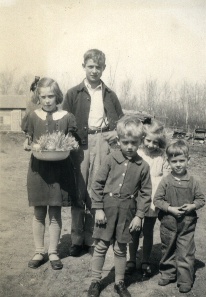COLUMN: Tales from the Gravel Ridge – The power of symbols
Advertisement
Hey there, time traveller!
This article was published 30/03/2024 (395 days ago), so information in it may no longer be current.
The month of March, as I remember it from my Rosengard childhood, signified important events in the life of my family. We generally consider spring to begin officially on March 21, although that may vary slightly from one year to another, depending on certain specific astronomical events. March 21 also marked the birthday of my father, Cornelius Falk. However, since my father was born in 1895, in the Mennonite village of Schoeneberg in what is now Ukraine, his birthday may well have been recorded in accordance with the “Old Style”, being the Julian calendar. Likewise, March 28, 1903, the birthday of my mother, Katarina Sudermann, born in Kamenka, also in Ukraine, I presume was also recorded in the Julian calendar format. Fast forward to 1929, my parents, Cornelius and Katarina Falk, having newly arrived in Canada, marked the birthday of their newborn son, Cornelius on March 24, according to the Gregorian calendar.
Birthdays in a sense are symbols in that they specifically celebrate, or at the very least mark the occasion of the birth of an individual. After all, if you are alive, you most certainly had a date of birth.
Symbols carry great significance. They are imbued with power that has the capacity to move us deeply. Religious symbols come to mind. Several years ago my husband and I were in Lisbon, and while walking along the street on a Sunday afternoon, we noticed, almost out of the way of the main thoroughfare, a small building with a symbol denoting a cross in the style of the Orthodox Church. A service was being held, and the door was open, accommodating the overflow gathering. It had caught my eye, almost in passing. However for Bernie, my husband, that symbol immediately took him back many decades, to a time when he would sometimes accompany his Baba, his maternal grandmother, to an Orthodox church service in Dauphin, Manitoba. Later in his youth, Bernie was working in a Dauphin funeral home, one purchased by the then owner from his paternal grandfather, Robert Lodge. Bernie distinctly remembers the religious symbols that would be used during funeral services, depending on whether the service would be Catholic, or Orthodox, or Protestant.

Having grown up in a Mennonite family, I was not exposed to religious symbolism in the conventional sense during my childhood. It is unlikely that a crucifix would have been found in any home in our neighbourhood, or for that matter, in our churches. Perhaps it was thought that symbols detracted from our worship instead of adding to it. Plaques with carefully lettered Bible verses however, were common, as were paintings of religious themes, on the walls of the homes of some families. I recall specifically a couple of paintings, one being of the Good Shepherd.
For many Mennonites in times past, and most certainly that was the case in my family, music was profoundly meaningful, carrying with it the full range of our emotions. Interestingly, although it has been many years, indeed decades since I have attended a German church service, the words of those hymns as well as oratorical music in which I have participated or heard in performance, carry for me even to this day, incredible power and solemnity.
So also does the Ukrainian Orthodox Easter greeting “Khrystos voskres” with the response “Voistynu voskres”, the translation being “Christ is risen” with the response “He is risen indeed.” This greeting became familiar to us and our children when over the years we celebrated Easter together with Bernie’s mother at the home of Uncle Michael and Aunt Nadia, all three of them having grown up with the rich traditions of their Ukrainian families. This greeting was very familiar to my parents as well, having been born and grown up in Ukraine.
